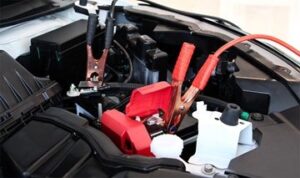Have you ever wondered why your brand-new battery is suddenly flat? It can be frustrating and unexpected, especially when you’re counting on your device to function smoothly. But worry not, for in this blog article, we will delve into the possible reasons behind this puzzling predicament and provide you with practical solutions to get your battery up and running again. So, let’s uncover the mystery of ‘Why Has My New Battery Gone Flat’.
Why Has My New Battery Gone Flat?
Introduction
If you’ve ever experienced the frustration of a new battery going flat unexpectedly, you’re not alone. It can be perplexing to invest in a brand-new battery only to have it lose its charge quickly. In this article, we will delve into the possible reasons why a new battery might go flat and provide you with practical solutions to prevent this from happening. We’ll cover common issues such as improper installation, parasitic drains, faulty alternators, and more. By understanding these causes, you’ll be better equipped to avoid battery troubles and enjoy worry-free driving.
1. Improper Installation
1.1. Loose or Corroded Battery Connections
One of the most common reasons for a new battery going flat is improper installation. If the battery connections are loose or corroded, it can hinder the flow of electricity and prevent the battery from charging properly. Here’s what you should check:
- Ensure the positive (+) and negative (-) terminals are securely tightened.
- Inspect the terminals for any corrosion buildup or rust. If present, clean them using a mixture of baking soda and water.
- Consider using a corrosion inhibitor spray to prevent future corrosion.
1.2. Incompatible or Defective Battery
Sometimes, the issue lies with the battery itself. It’s essential to ensure that the battery you’ve purchased is compatible with your vehicle’s specifications. Check the following:
- Verify the correct size, group, and cold-cranking amps (CCA) rating for your vehicle.
- If the battery is under warranty, consult the manufacturer or retailer for a possible replacement.
- Consider having a professional inspect your battery if you suspect it may be defective.
2. Parasitic Drains
2.1. Identifying Parasitic Drains
Parasitic drains are electrical loads that continue to draw power from the battery even when the vehicle is turned off. These drains can quickly deplete a new battery. To identify potential parasitic drains, follow these steps:
- Ensure all electrical components and accessories are turned off, including lights, radios, and interior lights.
- Disconnect any aftermarket devices that may drain power when the vehicle is off.
- Using a multimeter, set it to the DC ampere scale and connect it in series between the negative terminal of the battery and the negative cable.
- Wait for approximately 30 minutes to allow the vehicle’s electronic systems to enter sleep mode.
- If the multimeter reads a current draw of more than 50 milliamps (mA), there may be a parasitic drain present.
2.2. Resolving Parasitic Drains
Once you’ve identified a parasitic drain, it’s time to locate its source and resolve the issue. Here are some common culprits:
- Check for interior lights or trunk lights that may be stuck on or have faulty switches.
- Inspect the ignition switch to ensure it fully shuts off the electrical system when the vehicle is turned off.
- Consider installing a battery disconnect switch to easily cut power to the vehicle when not in use.
- Consult a professional mechanic or electrician for a comprehensive diagnosis and repair.
3. Faulty Alternator
3.1. Signs of a Faulty Alternator
The alternator plays a crucial role in charging the battery while the engine is running. If the alternator is faulty, it can lead to a new battery going flat. Look out for these signs of a failing alternator:
- Dimmed headlights or interior lights when the engine is running.
- Dashboard warning lights indicating a charging system problem.
- Difficulty starting the engine or frequent battery jump-starts.
- Strange noises coming from the alternator, such as grinding or whining.
3.2. Dealing with a Faulty Alternator
If you suspect an issue with your alternator, it’s essential to address it promptly to avoid further battery problems. Here’s what you can do:
- Perform a visual inspection of the alternator for any loose or damaged components.
- Check the drive belt for proper tension and signs of wear. Replace if necessary.
- Consider having a professional test the alternator’s output to verify if it’s charging the battery correctly.
- If the alternator is indeed faulty, replacing it with a new or rebuilt unit is usually recommended.
4. Extreme Weather Conditions
4.1. Cold Weather
Extreme cold weather can significantly affect a battery’s performance and lead to it going flat quicker than usual. Cold temperatures can cause the following issues:
- Reduction in battery capacity, making it harder to start the engine.
- Increased internal resistance, limiting the battery’s ability to deliver power.
- Slower chemical reactions within the battery, resulting in decreased overall performance.
4.2. Hot Weather
While cold weather can impact the battery, hot weather can also pose challenges. High temperatures accelerate the battery’s internal chemical reactions, leading to faster degradation. Here’s how you can mitigate the effects of extreme weather conditions:
- Consider using a battery insulation kit to protect it from extreme temperatures.
- Park your vehicle in shaded areas or use a car cover to shield it from direct sunlight.
- Keep the battery terminals clean and free from corrosion to maintain optimal performance.
5. Short Trips and Inactivity
Frequent short trips or leaving your vehicle unused for extended periods can contribute to a new battery going flat. This is because the alternator needs sufficient driving time to recharge the battery fully. Here are a few tips to avoid this issue:
- Avoid multiple short trips whenever possible. Combine errands to give the battery enough time to recharge.
- If your vehicle will be inactive for an extended period, consider using a battery maintainer or trickle charger to keep the battery charged.
- If you don’t have access to a battery maintainer, starting the vehicle and letting it run for 10-15 minutes every few days can help maintain the battery’s charge.
A new battery going flat can be frustrating, but understanding the underlying causes can help you avoid this issue in the future. By ensuring proper installation, addressing parasitic drains, checking for a faulty alternator, considering extreme weather conditions, and taking steps to prevent battery inactivity, you can prolong the life of your battery and enjoy reliable performance. Remember, if you’re unsure about any aspect of your vehicle’s electrical system, consulting a professional mechanic is always a wise decision.
Frequently Asked Questions
Why is my new battery going flat?
There could be several reasons why your new battery is going flat. Here are some possible explanations:
1. How long has the battery been unused?
If the battery has been sitting unused for an extended period, it may have lost its charge. Batteries can self-discharge over time, especially if they are not in use or stored properly.
2. Is the battery being properly charged?
Ensure that you are following the correct charging procedures for your specific battery. Different types of batteries require different charging methods. If you are not charging the battery correctly, it may not reach its full capacity.
3. Are there any power-draining accessories or devices connected?
Check if there are any accessories or devices connected to your battery that may be drawing excessive power. Certain accessories or devices, such as car stereos or GPS units, can drain the battery even when the main power is turned off.
4. Is the battery compatible with your device?
Verify that the battery you purchased is compatible with your device. Using an incompatible or low-quality battery can cause it to drain quickly or not hold a charge at all.
5. Could there be a faulty component?
In some cases, a faulty component within the device itself could be causing the battery to drain faster than usual. If you suspect this may be the case, it’s recommended to seek professional assistance or contact the manufacturer for further troubleshooting.
6. Have you checked for any software-related issues?
Occasionally, software glitches or background processes can cause excessive battery consumption. Make sure your device’s software is up to date and check for any settings or apps that may be unnecessarily draining the battery.
Final Thoughts
If you’ve found yourself wondering, “Why has my new battery gone flat?” there are several potential reasons to consider. Firstly, it could be due to a faulty battery. Sometimes, even new batteries can have defects. Secondly, it’s possible that there is a parasitic drain on your battery. Certain electrical components or accessories could be drawing power even when the vehicle is off. Finally, extreme temperatures can affect battery performance, causing it to discharge more quickly. So, if you’re facing this issue, check for battery defects, investigate any parasitic drains, and be mindful of temperature extremes.




